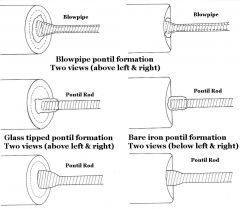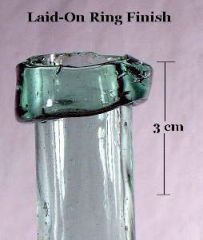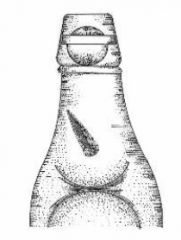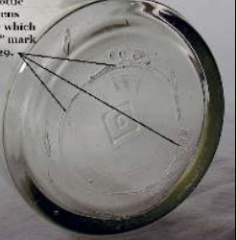![]()
![]()
![]()
Use LEFT and RIGHT arrow keys to navigate between flashcards;
Use UP and DOWN arrow keys to flip the card;
H to show hint;
A reads text to speech;
33 Cards in this Set
- Front
- Back
|
Three main ways to identify bottle types |
manufacturing technique bottle bases labelling and embossing |
|
|
1st glass bottles |
Free blown (handmade), only kind of glass bottles until 1730s. gob of hot glass on blow pipe, molded on a marver table, removed with a pontil rod, gets cracked off.
|
|
|
Pontil marks |

From pontil rod that gets glass off blow pipe.
|
|
|
Cracked off finish |

|
|
|
Laid on Ring |

Band of glass put around finish but wasn't worked in any way |
|
|
Applied Finish |
extra glass blob put on and a finishing tool is used (spun) made between 1820s-1920s |
|
|
Dip mold? |
free blown glass, dipped in a bucket to shape it, shoulders usually wider, no seams |
|
|
Tooled Finish |
1820s-1920s free blown glass has neck made extra long and a finishing tool is used on the mouth. Can usually see tool marks |
|
|
two piece mold |
1750s to 1880s for smaller bottles, seams run down sides and along base, could have embossed lettering |
|
|
three piece molds |
1830s to 1920s the brand name was Ricketts 2 shoulders, and base molds could have embossing on shoulders |
|
|
Post bottom |
1850-1930 seams down sides and base with a circular seam in center can emboss |
|
|
Cup bottom |
1850-1930 side seams and along base (not through it) |
|
|
Hutchinson stopper |
1879-1920 wire metal closure with rubber gasket, for pressurizing drinks |
|
|
Lightening closure |
1875-1920 wire neck closure |
|
|
Codd stoppers |
1872-1920 marble stopper popular in India and Japan |
|
|
Turn paste mold |
1870-1920 spin mold, very geometric no mold marks, seams no lettering |
|
|
Mechanization of bottle production? |
1881 multi-part molds (10+ parts) ghost seams from being moved from mold to mold |
|
|
Owen's machine |
1904 first fully automated bottle making does process backwards (finish, body, base) has air suction scars and feathering |
|
|
Crown seal finish |
1892-present |
|
|
solarized glass |
had magnese dioxide colourless until sunlight, then purple 1875-1918 |
|

|
ghost seams from multiple mold, mechanized bottle production (1881) |
|

|
applied finish (1820-1920) |
|

|
Tooled finish (1820-1920) |
|

|
Two piece mold illustration 1750-1880 |
|

|
Lightening closure 1875-1920 |
|

|
Codd stopper 1872-1920 |
|

|
Hutchinson stopper 1879-1920 |
|

|
Dip mold (free blown glass) |
|

|
Three piece mold bottle Rickett brand 1830-1920 |
|

|
Two piece mold 1750-1880 |
|

|
Post bottom 1850-1930 |
|

|
Cup bottom 1850-1930 |
|

|
Owen's scar 1904 fully automated |

